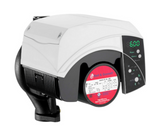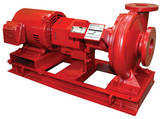Protect Water Heating Systems with Expansion Tanks
Protect Water Heating Systems with Expansion Tanks
Water has a tendency to expand when it is heated and it becomes nearly incompressible. These two things create a powerful force in a water heater. For example, the water in a standard 80-gallon storage tank may expand by as much as 2.5 gallons as it is heated, and this thermal expansion will cause a significant increase in the pressure in the plumbing system unless the extra fluid volume is adjusted.
Bell & Gossett Potable Water Diaphragm Expansion Tanks – ASME (PTA) are used to to control pressure build-up in closed, potable water systems. A water heater or water heating system in a building typically creates thermally expanded water. A thermal expansion tank that is properly sized will accommodate the additional volume of water through expansion during the heating cycle and also control the system pressure increases. It keeps pressures from reaching critical limits. The tank uses compressed air to maintain system pressures. It accepts and expels the changing volume of water as it heats and cools. These tanks are designed by using a flexing butyl barrier that separates the stored water from the captured pressure control air cushion. This barrier which is a replaceable bladder or fixed diaphragm, allows the water to be contained within the bladder. It prevents corrosion and potential water logging. These thermal expansion tanks are engineered to meet ASME standards. These are also available in non-code designs.
Pressurized thermal expansion tanks are different from plain steel expansion tanks. These have a flexible bladder or diaphragm that separates the air cushion from the system fluid. The air side pre-charge of the tank must be field adjusted to equal the system supply pressure. As the system water expands, the bladder expands open, pushing against the air cushion to accept the expanded water.
Main features
It accepts expanded water caused by thermal expansion. And returns water to the system when hot water is used. It also protects water heater and fixtures. It eliminates wasted energy and water. Preventing a dangerous pressure buildup it eliminates a potential safety hazard. These ASME tanks meet all Section VIII, Division I Standards as well. Every tank has a steel connector. It has deep drawn steel domes for maximum strength and endurance of pressure. Each tank has a rigid polypropylene liner for corrosion resistant reservoir with a Butyl Diaphragm for long life expectancy. Diaphragm’s Hoop Ring is mechanically grooved for permanent air-tight seal. The diaphragm tank has been developed in such a way that it allows the systems air cushion to be separated from the systems water. No waterlogging of the tank occurs as the air is held between the tank wall and the outside of a bladder placed inside the tank. The system water is contained inside the bladder. This changes the system to an air elimination system, as any air extracted from the system water is released out of the system into the atmosphere.
Why is the size important for expansion tank?
Air is compressible and, as the volume of water in the storage tank increases, the volume of air in the expansion tank decreases. This results in increasing the air pressure and eventually it increases the potable water pressure. This is why proper selection and proper sizing of the expansion tank is important. If the expansion tank is undersized and cannot absorb the additional pressure, the potable water pressure may exceed allowable limits and activate the storage tank’s T&P (aka relief) valve. This is a problem since the relief valve is a safety device; constant operation of the valve can lead to its failure, and to potentially dangerous consequences. Expansion tanks are available in various sizes. The size you may need would depend upon two very important variables. Firstly, you need to know the capacity in gallons of your hot water heater and the water pressure of your house piping system. The capacity of your hot water heater is stamped on a label or a plate on the side of your hot water heater. So, how do you determine your incoming water pressure? It is simple and easy. All you need is a little gauge that attaches to any faucet which has garden hose threads. You can easily get it at any plumbing house supplies store. Alternatively, you can call your local water department. They will send a technician to your house. This person has very accurate gauges which will do the same thing.
Once you have this information, visit a local plumbing supply house that sells these tanks. They will be able to help you with the proper sized tank to suit your needs.
Expansion tank installation
It would require you to install a simple tee fitting in your cold water supply line. You just need to extend a piece of pipe towards the floor out of this tee fitting. Many plumbers insist on hanging the tank up in the air. This might just lead to all sorts of stress on the pipe and fittings. You can just install the tank on the ground with a ball valve shutoff valve about a feet above the tank. You can place the tank on some wooden blocks. However, before doing anything read the instructions from the manufacturer very carefully.
Recent Posts
-
The Bell & Gossett Ecocirc XL Pump
The Bell & Gossett Ecocirc XL Pump: Innovation in Efficiency and ReliabilityIntroductionIn the w …18th Jul 2024 -
The Efficiency of The Bell & Gossett Series e-1510 Centrifugal Pump
Bell & Gossett Series e-1510 centrifugal pumps are one of the most efficient pumps in the market …22nd Mar 2023 -
How Important Is The Bell & Gossett Expansion Tank
Bell & Gossett expansion tanks are an important component in any hydronic heating or cooling system. …20th Feb 2023



